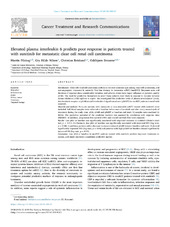| dc.contributor.author | Pilskog, Martin | en_US |
| dc.contributor.author | Nilsen, Gry Hilde | en_US |
| dc.contributor.author | Beisland, Christian | en_US |
| dc.contributor.author | Straume, Oddbjørn | en_US |
| dc.date.accessioned | 2020-07-02T07:42:03Z | |
| dc.date.available | 2020-07-02T07:42:03Z | |
| dc.date.issued | 2019 | |
| dc.Published | Pilskog M, Nilsen GH, Beisland C, Straume O. Elevated plasma interleukin 6 predicts poor response in patients treated with sunitinib for metastatic clear cell renal cell carcinoma. Cancer Treatment and Research Communications. 2019;19:100127 | eng |
| dc.identifier.issn | 2468-2942 | |
| dc.identifier.uri | https://hdl.handle.net/1956/23221 | |
| dc.description.abstract | Introduction: Clear cell renal cell carcinoma (ccRCC) is the most common type among renal cell carcinomas, and anti-angiogenic treatment is currently first line therapy in metastatic ccRCC (mccRCC). Response rates and duration of response show considerable variation, and adverse events have major influence on patient's quality of life. The need for predictive biomarkers to select those patients most likely to respond to receptor tyrosine kinase inhibitors (rTKI) upfront is urgent. We investigated the predictive value of plasma interleukin-6 (pIL6), interleukin-6 receptor α (pIL6Rα) and interleukin 6 signal transducer (pIL6ST) in mccRCC patients treated with sunitinib. Material and methods: Forty-six patients with metastatic or non-resectable ccRCC treated with sunitinib were included. Full blood samples were collected at baseline before start of sunitinib and after every second cycle of treatment during the study time. pIL6, pIL6R and pIL6ST at baseline and week 12 samples were analysed by ELISA. The predictive potential of the candidate markers was assessed by correlation with response rates (RECIST). In addition, progression free survival (PFS) and overall survival (OS) were analysed. Results: Low pIL6 at baseline was significantly associated with improved response to sunitinib (Fisher's exact test, p < 0.01). Furthermore, low pIL6 at baseline was significantly associated with improved PFS (log rank, p = 0.04). In addition, patients with a decrease in concentration of pIL6R between baseline and week 12 showed significantly improved PFS (log rank, p = 0.04) and patients with high pIL6ST at baseline showed significantly improved OS (log rank, p = 0.03). Conclusion: Low pIL6 at baseline in mccRCC patients treated with sunitinib predicts improved treatment response, and might represent a candidate predictive marker. | en_US |
| dc.language.iso | eng | eng |
| dc.publisher | Elsevier | eng |
| dc.rights | Attribution-Non Commercial-No Derivatives CC BY-NC-ND | eng |
| dc.rights.uri | http://creativecommons.org/licenses/by-nc-nd/4.0/ | eng |
| dc.title | Elevated plasma interleukin 6 predicts poor response in patients treated with sunitinib for metastatic clear cell renal cell carcinoma | en_US |
| dc.type | Peer reviewed | |
| dc.type | Journal article | |
| dc.date.updated | 2020-01-22T18:06:08Z | |
| dc.description.version | publishedVersion | en_US |
| dc.rights.holder | Copyright 2019 The Authors | |
| dc.identifier.doi | https://doi.org/10.1016/j.ctarc.2019.100127 | |
| dc.identifier.cristin | 1709610 | |
| dc.source.journal | Cancer Treatment and Research Communications | |

